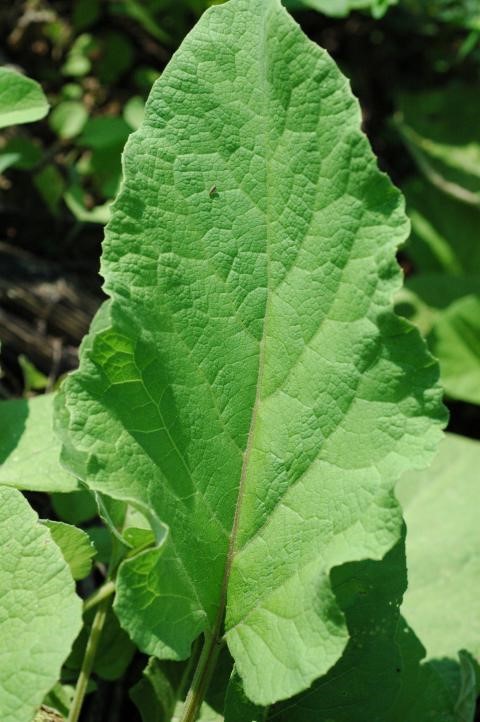Common burdock (Arctium minus) is a biennial plant that hosts pathogens that negatively impact a variety of native plant species. As this problematic invader thrives in uncultivated areas, it has become a primary target for vegetation managers working to enhance roadside safety, protect roadway infrastructure and support the development of low-growing plant communities beneficial to native wildlife species. As infestations of common burdock can be found in most regions of the United States, it is important that vegetation managers across the country know how to identify, treat and control them effectively.
What Does Common Burdock Look Like?
In its first year of development, common burdock develops as a rosette with leaves that grow anywhere from 4 to 14 inches wide and 6 to 18 inches long. In addition to their size, the plant’s leaves are distinguished by the following features:
Common Burdock Leaf Features
- Broad, heart-like shape
- Hollow petioles
- Light green, slightly hairy undersides
In its second year of development, common burdock produces a bushy flowering stem that commonly grows up to 5 feet tall. Compared with rosette leaves, the stem’s alternating egg-shaped leaves are much smaller. Flower head clusters take form at the end of upper stems and most commonly bloom between July and October. The heads of each flower are enclosed in a prickly bur and measure up to 1 inch wide. Once dried, the burs latch onto fur and clothing with their hooked bracts to help disperse thousands of viable seeds. Each plant typically produces an average of 15,000 seeds – its primary source(s) of reproduction.
Where Is Common Burdock Found?
Common burdock prefers nitrogen-rich soils and has been known to thrive in clay and moist loam. The plant can be found in uncultivated or disturbed sites, such as roadsides and the grasslands or woodlands adjacent to them. Considering its average height, large taproot and hosting of harmful pathogens, common burdock can compromise roadway infrastructure and visibility while threatening the sustainability of low-growing native plant communities.
How to Control Common Burdock Effectively
The most effective method of control for common burdock is spraying selective herbicides during its first year of development. Capable of effectively controlling more than 140 weed and brush species, TerraVue® herbicide from Corteva Agriscience can be applied at a rate of 2 to 2.85 oz./acre to successfully treat common burdock without causing harm to nearby desirable plants.
Vegetation managers who rely on mechanical mowing for vegetation control are encouraged to follow up mechanized treatments with applications of TerraVue as doing so significantly impedes future regrowth. If common burdock is left untreated until the second year of development, mowing must be completed before the plant has bloomed. Otherwise, mowing practices will simply spread the plant’s seeds and increase costs associated with re-treatments when the plant redevelops in the years that follow. Conversely, the effective use of selective herbicides can control common burdock effectively, allowing native plant species to develop and form a natural barrier against the plant’s reestablishment.
To learn more about the environmental benefits selective herbicide applications can provide to vegetation managers and native wildlife, visit HabitatWithHerbicides.com.
™ ® Trademarks of Corteva Agriscience and its affiliated companies. Under normal field conditions, TerraVue® is nonvolatile. TerraVue has no grazing or haying restrictions for any class of livestock, including lactating dairy cows, horses (including lactating mares) and meat animals prior to slaughter. Label precautions apply to forage treated with TerraVue and to manure and urine from animals that have consumed treated forage. TerraVue is not registered for sale or use in all states. Contact your state pesticide regulatory agency to determine if a product is registered for sale or use in your state. Consult the label for full details. Always read and follow label directions. © 2021 Corteva.



